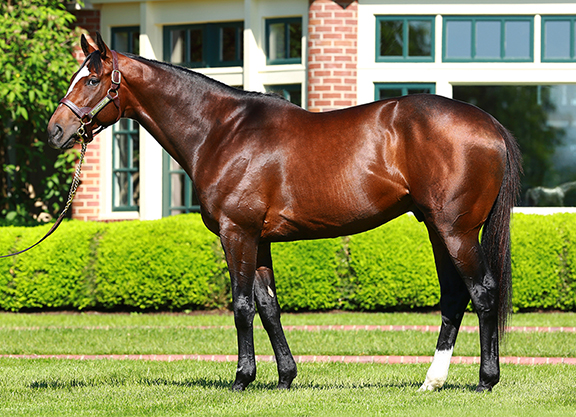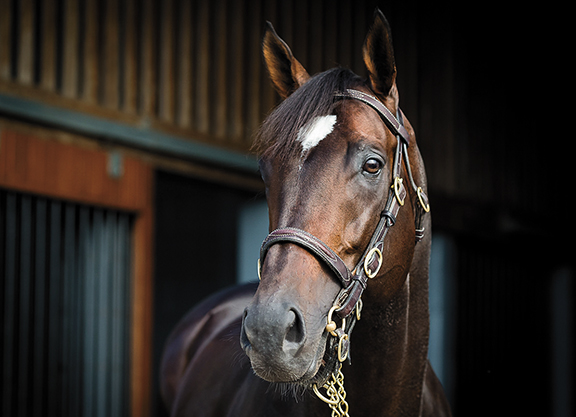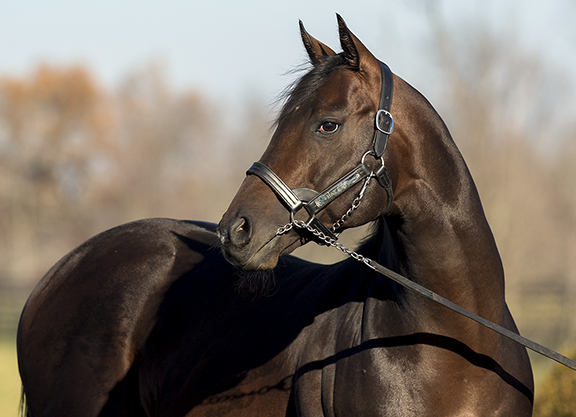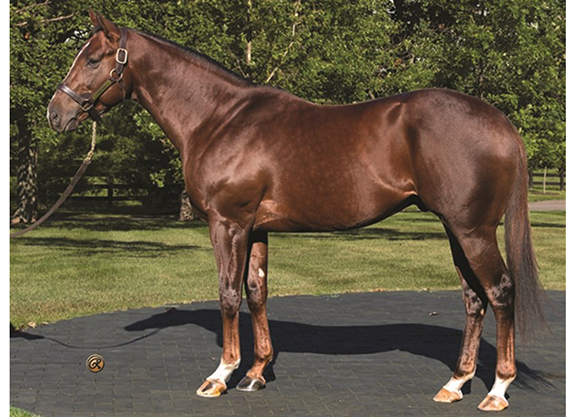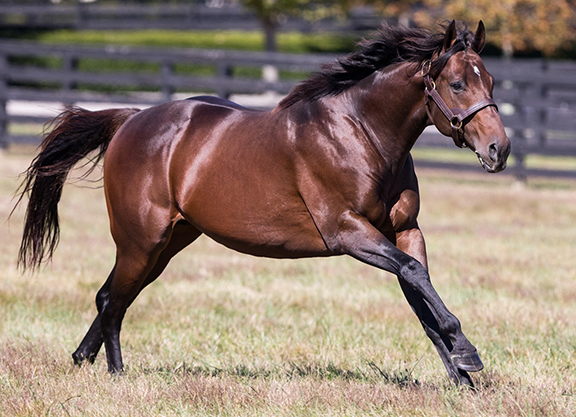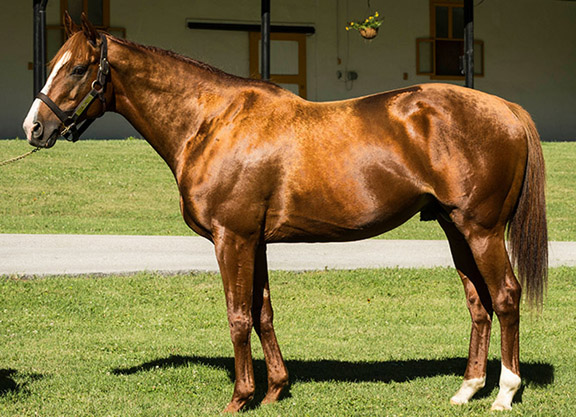By Chris McGrath
This is the second half of the latest instalment in our ongoing series examining stallion options for the new breeding season, featuring sires about to launch their third crop of juveniles. The first part, dealing with the likes of American Pharoah and Constitution, can be read here.
We wrapped up yesterday with the first two of three horses retired to Lane's End after filling the frame in an epic race for the GI Whitney S. in 2015. The third, Tonalist (Tapit–Settling Mist, by Pleasant Colony), has somehow always seemed to be working against the gradient, taking a series of fee cuts. But he actually had a very solid 2020 on the track, and has already fired out eight winners (including one at stakes level) in 2021. I am adamant that his maturing stock will keep consolidating, and evidently would not be alone in that view: his fifth book rallied conspicuously to 122 mares from 63 the previous year.
His latest fee trim, from $15,000 to $12,500, reflected the widespread troubles experienced by this lot with their third crop of yearlings (41 sold of 52 at $19,170, down from $51,394). As we noted yesterday, this is always a tricky moment for young stallions and this group were additionally broadsided by a pandemic economy. But I'd say that Tonalist now looks just about the best value around for getting into Tapit.
His is such a copper-bottomed, old-school package of performance (11 triple-digit Beyers in banking $3.6 million, applying that raking stride to meet challenges as diverse as the GI Belmont S. and GI Cigar Mile) and pedigree (like Havre de Grace {Saint Liam}, he takes the Toll Booth route to fourth dam Missy Baba). First three dams by Pleasant Colony, Topsider and Buckpasser, Classic influences top to bottom–and I'm duly seeing some big-hearted animals fighting his corner, notably graded stakes-winning sophomores Tonalist's Shape and Country Grammer.
Tonalist, who himself reached his racing peak at four, is only just getting started. Yet his five graded stakes performers in 2020 arrived at a ratio more or less in step with Constitution, the pair behind only American Pharoah and comfortably ahead of every other stallion in the intake bar one.
Karakontie
-2014-bc14mi05a_WEB-cg_Horsephotos.jpg" alt="" width="576" height="417" /> Karakontie | HorsephotosThat exception is Karakontie (Jpn) (Bernstein–Sun Is Up {Jpn}, by Sunday Silence), who is quietly becoming quite a story at Gainesway.
We actually awarded him gold on our “value podium” for this group last year, succeeding Liam's Map whose fee had climbed from $20,000 to $35,000 in the meantime. Nobody could expect Karakontie to elevate his own fee in the same way, given the commercial disdain for turf stallions, and he will again stand at $10,000 in 2021. But there's no doubting his broader momentum.
His first three books comprised 113, 75 and 43. So far, so familiar. But he then inched back up to 69 and last year received 88 mares as merits continued to accumulate. Okay, so third place in the yearling averages this time round was rather flattering–the result of a relatively small footprint, combined with the deep impression made by a $500,000 session-topping colt at Keeneland. Generally speaking, he has predictably struggled for traction at the sales–but that sooner reflects the market's inane terror of turf than any inherent deficiency.
And after an encouraging start with his first juvenile runners (a dozen winners, three at stakes level), Karakontie collected his five black-type winners in 2020 as 7% of starters–a superior clip even to American Pharoah and Constitution, never mind the rest of their intake.
These included a Grade II winner on the dirt in Princess Grace, while Sole Volante earned a Derby gate as one of the most talented dirt sophomores of the Florida spring. Karakontie has also made an impression in Europe, again from small numbers, Group winner Kenzai Warrior similarly earning a crack at the G1 2,000 Guineas. There can't be many stallions at this kind of money who have managed a Classic starter on both sides of the ocean at the first attempt. Actually Noble Mission (GB) (Galileo {Ire}) did precisely that, in the previous intake, but Sole Volante and Kenzai Warrior both cost just $6,000 as yearlings.
So Karakontie has already proved himself adaptable as well as able to recycle some of the very best genes in the Stud Book. His third dam is Miesque herself, his granddam duly a three-parts sister to Kingmambo; and in his racing career Karakontie reiterated how this family has always straddled the ocean: in his homeland he was a Group 1 winner at two, and then a Classic winner before shipping to post a 110 Beyer in the GI Breeders' Cup Mile.
While commercial breeders continue to choke on grass, anyone whose first priority is to decorate a family with actual winners must surely think about Karakontie.
From the same barn as Sole Volante, another to put his young sire straight on the Classic trail was Ete Indien, whose runaway success in the GII Fountain of Youth similarly confounded any assumption that the genes of Summer Front (War Front–Rose of Summer, by El Prado {Ire}) would necessarily confine him to turf.
The Airdrie sire did have a Grade II winner on grass, Speaktomeofsummer, and his turf earnings for the year were only surpassed among this group by American Pharoah himself. But both sire and damsire are more versatile influences than is sometimes allowed, and Summer Front's dam–responsible for a Grade I juvenile scorer on synthetics in Laragh (Tapit)–is a half-sister to a Grade I winner on dirt in Siphonic (Siphon {Brz}).
What a $10,000 cover can give you, regardless, is something cut from the same beautiful cloth: Summer Front made $475,000 as a yearling when War Front was himself still only a $15,000 cover. Sure enough, he achieved something quite exceptional in this market by actually advancing the value of his third crop of yearlings: 24 of 37 sold for $41,335, up from $36,106 the previous year. Bearing in mind that his first crop had weighed in at $52,645, he has maintained a remarkably resilient yield for his supporters. No wonder he was also able to welcome 83 mares last spring, back up from 59 the previous year.
Having had three-figure books to that point, he will maintain the traffic in the meantime; while the stock already out there will surely keep progressing, too. Though an undefeated stakes winner at two, Summer Front proceeded to graded stakes success in each of the next three seasons, and was placed for the fifth time at Grade I level at six. All told, he is moving forward at a time when so many of these are in reverse.
Another I liked all along is Bayern (Offlee Wild–Alittlebitearly, by Thunder Gulch); his fourth book was down to 48 (following 350 across his first three) and then he had just a handful of mares to keep him in the game last year. Yet he has actually made a prolific start on the track: no fewer than 23 of his 54 juvenile starters reached the winner's circle in 2019, while his overall tally last year was 57 from 99 into the gate. He has made a lively start to 2021, too, with three stakes performers already including Leggs Galore, who won her fourth straight in the Sunshine Millions Filly & Mare Turf Sprint at Santa Anita last weekend.
Bayern has admittedly lacked a headliner or two, with a solitary Grade III winner to this point, but remains entitled to put that right as he draws on the fabulous pedigree (third dam is Courtly Dee!) that sustained the sophomore brilliance to win the GI Breeders' Cup Classic (broke two minutes) after a seven-length sprint romp in the GII Woody Stephens.
His sire is admittedly 'offlee' offbeat, at least to those who forget he was champion freshman before his hasty export; and Bayern doubtless paid also for persevering into an unproductive campaign at four. But he did manage an impressive sales debut and it has been mystifying to see him go so cold so quickly. He steadied the ship at $29,059 for 18 sold of 25 this time round, and Hill 'n' Dale at Xalapa have halved him to $7,500 in the hope of a revival. Looking at some of the timeless names entwined in his pedigree, I would urge keeping the faith.
After all, he did have eight stakes performers in 2020, which is one more than Carpe Diem (Giant's Causeway–Rebridled Dreams, by Unbridled's Song) from a rather more industrial output. WinStar have similarly halved this fellow to $7,500, as he awaits a first graded stakes success. He has the volume, for sure, having originally traded at $25,000 and herded 569 mares across his first four years. And if he was another to fall right off in his fifth book, the slump in his third crop of yearlings (from $60,969 to $21,747, for 41 sold of 53 offered) is another that needs placing in due context.
As we're seeing, that's proving a pretty standard experience–tricky stage, tricky market–and he may yet rally. In the span of a bright but brief career he managed Grade Is at two and three, beaten only by Texas Red (Afleet Alex) at the Breeders' Cup before derailing in the Derby. As a $1.6-million sale-topping juvenile who wired a sprint maiden at Saratoga, he was unusually precocious by the standards of Giant's Causeway and was also his only elite scorer on dirt. But he may need to summon some of his sire's slower-burning genes if he is to kick-start things now.
It has been a somewhat chastening year for Palace Malice (Curlin–Palace Rumor, by Royal Anthem), who slipped from third in the freshmen's championship to 13th in the second-crop table. But there will be no panic at Three Chimneys, because a Breeders' Cup success at the first attempt (through Structor in the Juvenile Turf) drove his fifth book up to a giddy 207 at $25,000. A mild trim to $20,000 should help him ride out any faltering now; his earlier books have been a little up and down–158, 117, 65, 91–while he was yet another to share the big slide with his latest yearlings, down to $32,083 (for 18 sold of 23) from $73,899.
On the track he had a very similar profile to Tonalist, winning the Belmont before dropping back to win a Grade I mile at four and racking up eight consecutive triple-digit Beyers. So he, too, is entitled to hope for some progressive stock to redress his misfortune in losing the services first of his flagship Structor; and then of the sophomore who stepped into the breach, Mr. Monomoy, who likewise disappeared after winning the GII Risen Star S. After all, Palace Malice is from the first crop of Curlin, who recycles the Smart Strike trademark of thriving with maturity.
On the same roster Fast Anna (Medaglia d'Oro–Dreaming of Anna, by Rahy) had a rather tepid second year on the track, with a single black-type winner, but while he is experiencing the same kind of drag as so many others in this group–third crop down to $18,470 from $40,500 for 11 sales of 17–he represents a cross that might permit him to develop any number of ways.
As a brisk and natural runner himself, collared in the GI King's Bishop on only his third start having been unraced at two, his career attests to the flexibility of his sire line and his second dam is a half-sister to one of its greatest scions in Kitten's Joy. These diverse influences are complemented by the celebrity of his dam as a champion 2-year-old filly.
Fast Anna had actually made a decent start as a freshman, with three of his 11 winners scoring at black-type level, earning a hike to $10,000 from $7,500. But he's now been helped with a trim to $5,000, his opening book of 120 mares having meanwhile dwindled by around half.
The El Prado (Ire) line has obviously been a game-changer for Ramsey Farms and they have another representative in We Miss Artie (Artie Schiller–Athena's Gift, by Fusaichi Pegasus). He's not getting anything like the numbers required to emulate Kitten's Joy, so did especially well to pull a homebred as talented as Artie's Princess out of his hat from just a couple of dozen starters in 2020. She took her record to five-for-seven in winning the GII Bessarabian S. on a surface much like the Keeneland synthetic on which her sire won the GI Breeders' Futurity.
Halved to the same $5,000 fee at Lane's End we find Mr Speaker (Pulpit–Salute, by Unbridled). Pretty tempting, surely, about a young stallion who could produce GI Ashland S. winner Speech from a $7,500 mare. True, it was a quiet year otherwise, but he had nothing like the volume of most of these on the track and a healthier strike rate too.
I feel really sorry for this guy, who was always wading against the tide after being stranded for a year in Chile, his yearlings largely ignored this time round (19 of 22 processed at $16,026) after their absence the previous year. We know that owning a Grade I on turf will also have unnerved some commercial breeders, but even the most myopic can surely notice that his dam was a GII Demoiselle S. runner-up out of Personal Ensign herself. He will have to ride out a bumpy road, few having kept the faith last spring, but he deserves a break having already parlayed those genes into a Grade I winner from cheap material. Hang in there, dude.
Another who promises versatility is Lea (First Samurai–Greenery, by Galileo {Ire}) at Claiborne. It feels like quite a while since he was one of the buzz sale rookies, showcasing a $650,000 colt from a first crop conceived at $12,500. He experienced the same travails as most of these with his latest yearlings ($15,417 for 26 sold of 31), and mustered a tiny fifth book, but remains a valid option for those who might want to tap into his damsire, a rare privilege over here, along with the hardiness and versatility he showed on the track.
Not many horses could be collared only late in the GI Woodmine Mile on turf before chasing home Liam's Map in the GI Breeders' Cup Dirt Mile next time. His durability (better than ever in his fourth season) gives him a chance to consolidate on three black-type winners from 68 starters in 2020–actually in a much better ratio than most of these.
We're now in territory where nothing instructive can be gained by dredging yearling averages and book sizes. But we love the Crestwood roster and those healthy enough not to share the commercial allergy to chlorophyll will want to think about Jack Milton (War Front–Preserver, by Forty Niner) at $6,500 after he produced a couple of smart ones from his small second crop.
Unfortunately one of these disappeared after following up a 'TDN Rising Star' debut with a Saratoga stakes success, but the other gave Jack Milton a first graded stakes and, from this farm, we know to expect horses that thrive with maturity. Sure enough, Jack Milton was a graded stakes winner at three, four and five (when he won his Grade I). No less typically, for this farm, he extends an aristocratic family tracing to the Claiborne matriarch Bourtai.
Even at the very bottom rung of the ladder, at $2,500, lurks lingering potential. Sky Kingdom (Empire Maker–Sky Beam, by Kingmambo) couldn't convert his regal genes (dam out of Classic-placed half-sister to A.P. Indy) into success beyond Grade III level, but he held his form through five seasons and has produced a couple of good ones from a very small pool.
Even before doing so he had scored a couple of hits at the sales, with a $185,000 yearling filly and a $875,000 2-year-old. The latter turned out to be Wrecking Crew, placed in the GI Breeders' Cup Juvenile, and already since the turn of the year Sky Kingdom has advanced a flagship for his second crop: Australasia won the Louisiana Jewel S. by daylight at Delta Downs last week.
There are plenty of stallions covering a cavalry of mares at much bigger fees who could really do with a couple of early talents like these. So let's not be complacent that any of these sires–whether for better or worse–are necessarily in the right tier of the marketplace.
CHRIS McGRATH'S VALUE PODIUM
Gold: Tonalist ($12,500, Lane's End)
Nobody ever talked him up in the sales pavilion bar but now he's quietly starting to make his own case where it counts most.
Silver: Summer Front ($10,000, Airdrie)
Has proved exceptionally resilient in the sales ring and the type to keep building on an equally solid start on the track, including on dirt.
Bronze: Karakontie (Jpn) ($10,000, Gainesway)
Market prejudice against turf makes it hard to retain the top step but already clear that he's recycling those regal genes.
Not a subscriber? Click here to sign up for the daily PDF or alerts.





